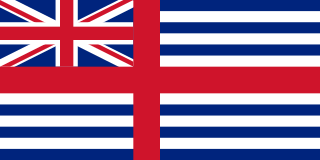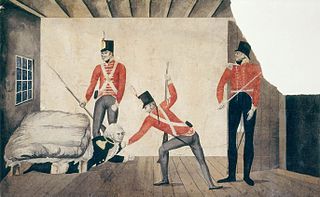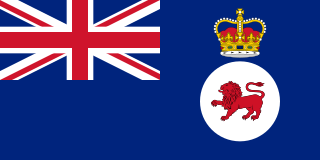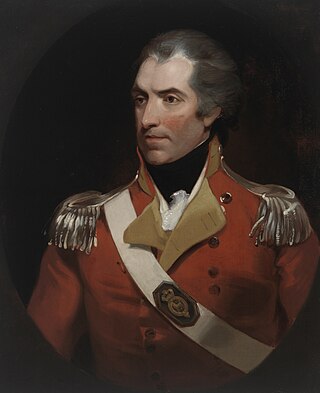| |||||
| Decades: | |||||
|---|---|---|---|---|---|
| See also: | |||||
The following lists events that happened during 1806 in Australia.
| |||||
| Decades: | |||||
|---|---|---|---|---|---|
| See also: | |||||
The following lists events that happened during 1806 in Australia.

Van Diemen's Land was the colonial name of the island of Tasmania used by the British during the European exploration of Australia in the 19th century. A British settlement was established in Van Diemen's Land in 1803 before it became a separate colony in 1825. Its penal colonies became notorious destinations for the transportation of convicts due to the harsh environment, isolation and reputation for being inescapable. Macquarie Harbour and Port Arthur are among the most well-known penal settlements on the island.

The Rum Rebellion of 1808 was a coup d'état in the then-British penal colony of New South Wales, staged by the New South Wales Corps in order to depose Governor William Bligh. Australia's first and only military coup, the name derives from the illicit trade of rum in early Sydney, over which the 'Rum Corps', as the New South Wales Corps became known, had maintained a monopoly. During the first half of the 19th century, it was widely referred to in Australia as the Great Rebellion.

The governor of Tasmania is the representative in the Australian state of Tasmania of the Monarch of Australia, currently King Charles III. The incumbent governor is Barbara Baker, who was appointed in June 2021. The official residence of the governor is Government House located at the Queens Domain in Hobart. As the sovereign predominantly lives outside Tasmania, the governor's primary task is to perform the sovereign's constitutional duties on their behalf.

Colonel William Paterson, FRS was a Scottish soldier, explorer, Lieutenant Governor and botanist best known for leading early settlement at Port Dalrymple in Tasmania. In 1795, Paterson gave an order that resulted in the massacre of a number of men, women and children, members of the Bediagal tribe.

William Sorell was a soldier and third Lieutenant-Governor of Van Diemen's Land.
The following lists events that happened during 1804 in Australia.
The following lists events that happened during 1805 in Australia.
The following lists events that happened during 1807 in Australia.
The following lists events that happened during 1808 in Australia.
The following lists events that happened during 1817 in Australia.
The following lists events that happened during 1854 in Australia.
The following lists events that happened during 1855 in Australia.

John Webber was an English artist who accompanied Captain Cook on his third Pacific expedition. He is best known for his images of Australasia, Hawaii and Alaska.
Edward Abbott was a soldier, politician, judge-advocate and public servant who served at Parramatta, the Hawkesbury River and Norfolk Island in the colony of New South Wales, now part of present-day Australia. He also served at the settlements of Launceston and Hobart in Van Diemen's Land, which was part of New South Wales until 1825, when Van Diemen's Land became a self-governing colony.
Anthony Fenn Kemp was a soldier, merchant and a deputy judge advocate of the colony of New South Wales. He was one of the key participants in the "Rum Rebellion" that removed William Bligh, the appointed governor of the colony, and established an interim military government. He was later permitted to settle in Van Diemen's Land and became a successful merchant and farmer there.
HMCS Integrity was a cutter built by the Colonial Government of New South Wales in 1804. She was the first vessel ever launched from a New South Wales dockyard and carried goods between the colony's coastal settlements of Norfolk Island, Newcastle, New South Wales, Van Diemen's Land and Port Jackson. In 1804 she took part in a series of voyages to Van Diemen's Land with the aim of founding a colony at Port Dalrymple, the site of the modern settlement of George Town, Tasmania.
The Australian Historical Monographs are a series of historical studies privately printed by George Mackaness.
HMS Porpoise was the former mercantile quarter-decked sloop Lord Melville, which the Royal Navy purchased in 1804 to use as a store-ship.
William Gore was a provost marshal in the Colony of New South Wales during the early 1800s. During the Rum rebellion he was imprisoned for his support of Governor William Bligh. Gore was released after two years but later in his career was again incarcerated for unpaid debts and for wilfully shooting a soldier.

Captain William George Carlile Kent was an officer in the Royal Navy, who was involved in the early settlement of the Colony of New South Wales, Australia.